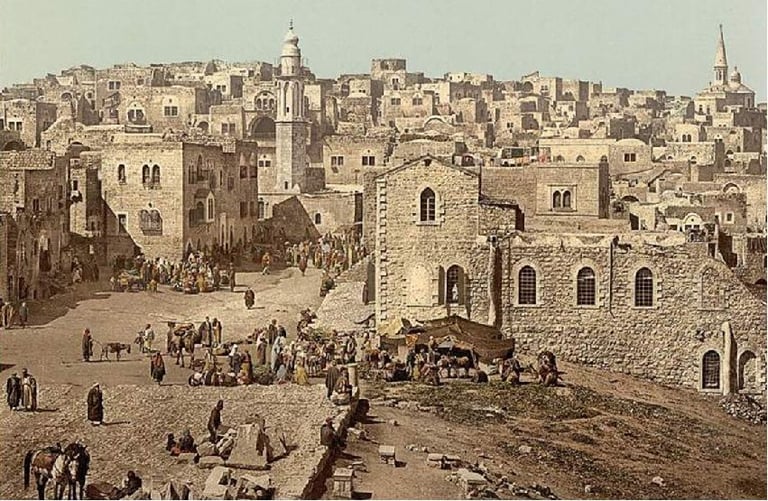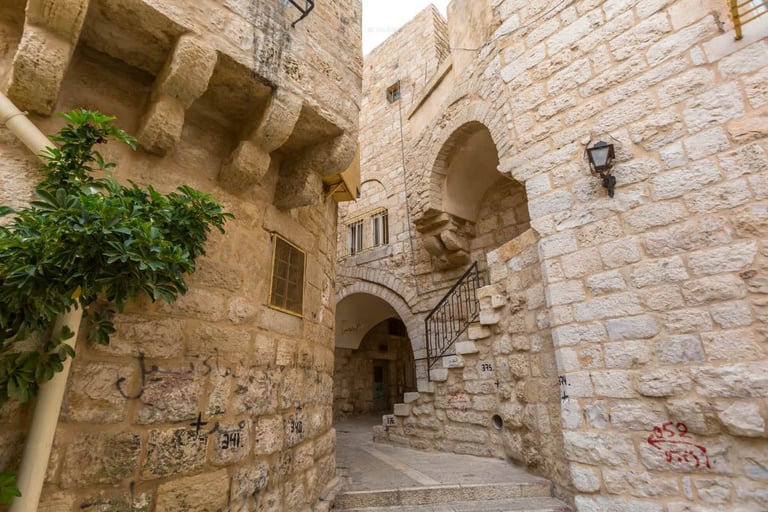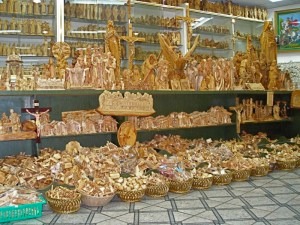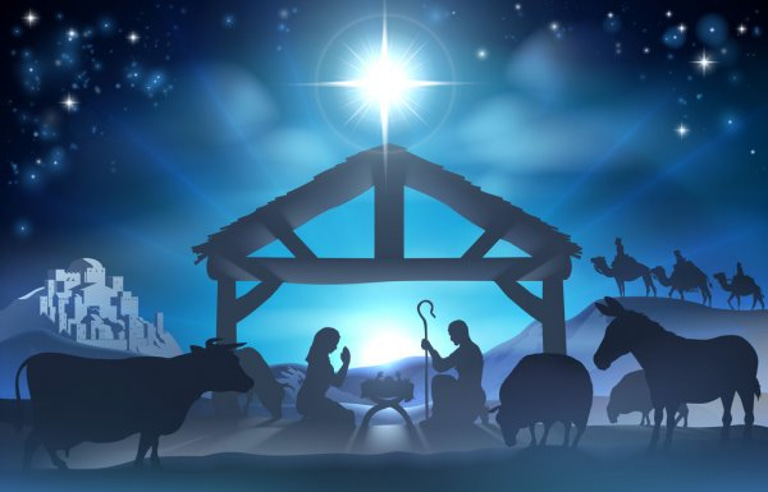First Century Bethlehem: A Journey Back to the Birth of Jesus
First Century Bethlehem offers a unique glimpse into early Christian roots. Uncover the stories that shaped this sacred town. Start your journey into history today.
Grace Callahan
11/18/20246 min read


In the first century, Bethlehem was a modest and relatively quiet village—distinct from the bustling metropolis of Jerusalem yet connected to the grand narrative of the Jewish people. It was here that the Messiah was born, but Bethlehem was not a city of power or grandeur. Rather, it was a humble village that would see the birth of a child who, Christians believe, would change the world forever.
Come with me on a journey through time as we explore Bethlehem in the first century, a place where faith, history, and tradition intertwined to create the backdrop for one of the most important events in human history—the birth of Jesus Christ.
Bethlehem’s Place in the Jewish World of the First Century
The first-century context of Bethlehem can best be understood within the broader framework of the Jewish world at the time. In 1st-century Judea, the people lived under the rule of the Roman Empire, which had conquered and subjugated the region several decades earlier. The Roman Empire, with its imposing military presence and vast network of governance, dictated the daily lives of the Jewish population. Yet, even under Roman rule, the Jews maintained their rich religious traditions, centered on the Torah (the Jewish law) and the worship of the one true God.
Bethlehem: The City of David
Bethlehem was not a large city by any means, but it carried immense symbolic weight for the Jewish people. This was the birthplace of King David, the revered leader and ancestor of the coming Messiah, as foretold in Jewish prophecies. In Micah 5:2, the Old Testament prophet had declared that the Messiah would come from the town of Bethlehem—the City of David. As a result, Bethlehem was known as a place of great prophetic significance in Jewish tradition.
While Jerusalem was the political and religious heart of the Jewish world, Bethlehem was a quiet, rural town that represented the humble origins of Israel’s greatest king, David. For the people who lived in Bethlehem, the prospect of a Messiah coming from this small town was a powerful part of their collective hope. The notion of a Davidic Messiah, a descendant of King David who would restore the kingdom of Israel and liberate the Jewish people from Roman oppression, was a central part of Jewish Messianic expectation in the first century.
The Roman Influence: Politics, Taxes, and Oppression
By the first century, Judea was an integral part of the vast Roman Empire. While Rome allowed the Jewish people to maintain their religious practices, it imposed strict political and military control over the region. Herod the Great, the client king of Judea, ruled over the region with the approval of the Roman authorities. He was known for his grand building projects, including the renovation of the Second Temple in Jerusalem, but also for his cruelty and paranoia. His reign was marked by taxation, oppression, and constant tension between Jewish hopes for a Messiah and Roman rule.
Roman Presence in Bethlehem
Although Bethlehem was a small, rural town, the influence of the Romans would have been felt in various aspects of life. Roman soldiers likely stationed in nearby cities or towns may have traveled through Bethlehem on occasion, keeping the local population under control. The Roman Empire’s reach was long, and even small towns like Bethlehem were subject to the Roman census, which was meant to register the population for tax purposes and military service.
The census decreed by Emperor Augustus in the Gospel of Luke was a pivotal moment in the Nativity story. This Roman tax required all people to return to their ancestral homes to be registered. This brought Mary and Joseph from Nazareth to Bethlehem, where Jesus would be born. For the Jewish people living under Roman rule, the census was yet another reminder of their subjugation to a foreign power.
While the Romans brought stability and infrastructure to Judea (through roads, aqueducts, and urban planning), they also imposed heavy taxes and took much of the wealth from the Jewish people to support the empire. Life for the average Jew in Bethlehem would have been hard, with much of the labor force engaged in agricultural work or small-scale trades. They lived in close-knit communities where faith and family were central to their lives, but there was a constant tension with the occupying Roman forces.
Jewish Religious Life in First-Century Bethlehem
The Jewish people of Bethlehem lived according to the Jewish Law, which governed every aspect of life, from religious festivals to personal conduct. In the first century, the Jewish community followed a strict religious calendar that involved regular sacrifices at the Temple in Jerusalem (when possible) and observance of festivals such as Passover, Pentecost, and Tabernacles.
The Synagogue: Center of Worship and Learning
Bethlehem, as a Jewish town, would have had a synagogue, where men gathered to pray and study the Torah. Synagogues were vital centers of Jewish worship and community life, particularly in towns and villages. The synagogue in Bethlehem would have been a place for teaching, reading from the Scriptures, and engaging in communal prayer. It was a space that reinforced both Jewish identity and tradition, even in the face of Roman occupation.
Bethlehem’s religious life would have also been marked by ritual purity laws and daily practices such as ritual washing and prayer. The temple in Jerusalem, though distant, was the holiest site in the Jewish world. Many Jews believed that the arrival of the Messiah would coincide with a time when the Temple would be restored to its former glory.
The Birth of Jesus: A Humble Beginning in a Turbulent Time
Amidst the turbulent political climate of Roman Judea, the birth of Jesus in Bethlehem was a profoundly humble and significant event. According to the Gospel accounts, Mary and Joseph traveled from Nazareth to Bethlehem to comply with the Roman census. They were likely part of a larger Jewish caravan making the journey to their ancestral homes, but their arrival in Bethlehem marked the beginning of something extraordinary.
A Humble Birth in a Stable
When they arrived in Bethlehem, the couple found that there was no room for them at the local inn (likely a crowded guesthouse). They took refuge in a stable, where Jesus was born in humble surroundings—far from the palaces or the grand halls one might expect for a king. The simplicity of Jesus’ birthplace, often depicted in nativity scenes with manger and animals, reflects a deep theological truth in Christian belief: the Messiah, the Savior of the world, was born not into wealth or power, but into poverty and humility.
The Shepherds and the Angels
The shepherds, another key part of the Nativity story, were ordinary laborers living on the outskirts of Bethlehem. Shepherding was a common profession, and many of the surrounding hills were used for grazing flocks. The angels who appeared to the shepherds, proclaiming the birth of the Savior, offered a unique message. These lowly shepherds were the first to hear the good news, symbolizing the inclusive nature of Jesus’ mission: the Messiah was not just for the powerful or the elite but for the poor and the marginalized as well.
Daily Life in Bethlehem During the First Century
Beyond the events surrounding Jesus’ birth, daily life in Bethlehem in the first century was marked by traditional Jewish customs and the rhythms of rural life. Most people lived in simple stone houses made from locally sourced materials like limestone and mud bricks. The town’s economy was based on agriculture, with many families engaged in farming, livestock raising, and artisan work.
Markets and Social Life
Bethlehem would have had a marketplace, where people bought and sold goods, exchanged news, and caught up with friends and neighbors. The presence of Roman soldiers and officials would have brought an added layer of tension to everyday life, as they often had the authority to collect taxes or enforce laws. Despite this, Bethlehem would have maintained its strong sense of community.
The religious festivals like Passover, Pentecost, and Sukkot would have been the highlights of the year. The people of Bethlehem, like other Jews in Judea, would have traveled to Jerusalem during these festivals to offer sacrifices at the Temple. However, in quieter times, the small-town atmosphere would have been marked by community gatherings, religious observance, and family life.




Souvenir shop today

